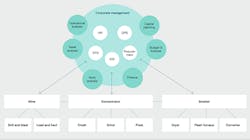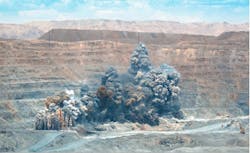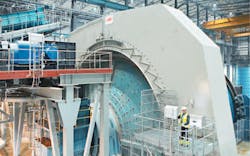1 Functional silos in copper mining
Breaking down silos is challenging as there are a number of historical and structural reasons that support the status quo, including geographic distribution of the operations, complexity of the planning process, the fractured software marketplace servicing the industry and the misalignment of performance metrics ➔ 1. For example, in a hard rock mining situation (eg, copper or gold), mining engineers often control costs by reducing blasting ➔ 2. This ends up increasing overall cost of the operations because poorly fragmented material is delivered to the plant, dramatically increasing milling costs and, more importantly, decreasing throughput.
2 Quarry blast at a gold mine
The tyranny of distance
Mining operations are often distributed over a large geographical area. For example, an iron ore supply chain may consist of several mines, multiple plants, a rail network and one or more ports that are all spread over several hundred kilometers. In turn, the chain of professionals responsible for running different aspects of the operations, such as geologists, mining engineers, metallurgists, supply chain planners and the sales team, are also geographically dispersed. This makes the daily, informal collaboration required to optimize the business almost impossible.
Many mining companies are responding to this tyranny of distance by creating remote operations centers (ROCs) that accommodate and centralize key operational processes in a single, conveniently located facility. Although there are many benefits, such as improved safety, reduced travel and better living conditions for key staff, the most important outcome for many miners is getting all the key decision makers in a single room each and every day to ensure the entire operation runs optimally.
ABB has a long history of helping other industries, such as pulp and paper and oil and gas, to dramatically increase efficiencies through ROCs and has more recently brought this experience to bear in the mining sector. Ventyx, with a broad suite of mining industry specific applications covering geological modeling, mine design, product inventory management, asset management and sales and marketing, provides a key differentiator for ABB's traditional ROC offering by expanding the software platform to cover all key operational processes, not just those typically covered in process automation.
The complexity of coordination
Planning complexity is also a major contributor to suboptimal organizational performance, particularly over the long term.
There are many components of a mining operation that need to be coordinated for the operation to function.
For example, the mining sequence has to take into account the geometry and quality of the orebody to achieve a consistent feed of ore to the downstream processes. This has to interact with the maintenance plan – equipment capacity needs to match the mine plan. Similarly, capital spending and financial planning have to tie in with these production and maintenance plans. For many commodities, the sales plan, which results in contracted commitments, has to connect with all these plans and work with infrastructure (eg, rail and port) capacity constraints.
It is hard enough to get a single feasible plan together, never mind working through multiple iterations to achieve an optimal plan. The agility of the organization is also compromised if external factors, such as commodity prices or infrastructure capacity, change and force a re-plan. This fragmented approach to planning results in many months of sub-optimal performance within the changed world.
The path to integrated operational planning has many stages. Because of the technical complexity and site specificity of mining industry information system requirements, a typical mining operation's software environment requires a broad range of specialist operational technology platforms, such as plant process automation and mining fleet management systems, as well as planning and management software including mine planning, optimization of short and long term plans, plant reporting, stockpile management, site worker management, logistics optimization, asset management and the list goes on.
By continuing to rely on separate solutions, however individually robust, mining operations will continue to be hampered by informal, spreadsheet-based integration points between those solutions, which thwart cross-functional communication, impede process optimization and introduce uncertainty into decision-making. To enable business process improvement, formal and integrated IT solutions must replace informal, spreadsheet-driven processes.
However, solution modules must be configurable to adapt to both department and enterprise-level needs. Each functional area can then "add value" to the overall operations process by providing its critical piece from which the complete "information picture" is created. Data management can then be largely automated and rules-based, freeing technical experts to focus on optimizing the value chain end-to-end through improved collaboration.
For example, mining, processing and logistics areas all have requirements for planning, scheduling and optimizing operations at the departmental level. However, there is a growing recognition of the business need to optimize these tasks across the operation, commodity or region. Cross-functional integration is essential to taking an enterprise level approach, but this has repeatedly proven to be prohibitively costly, slow and failure- prone across multi-vendor IT environments.
As IT and OT converge, more real-time data on asset condition will be available to streamline maintenance effectiveness, enabling condition-based monitoring. When business analytics are applied to this wealth of real-time data, miners can get high-value insights into the real condition of these critical assets. Furthermore, material tracking sensors can update the supply chain model, which can then be used for better short-term planning and scheduling, helping the company eliminate unneeded costs.
Again, Ventyx provides solutions covering the entire value chain and is uniquely placed to understand what this integrated "information picture" should look like and has the capability to bring it together. Once the underlying information architecture is sound, integrated operational planning can become a reality – this is a key area of research and development within Ventyx.
As a very simple example of what can be achieved with integrated planning, supply managers look to drive supply costs down, while maintenance managers need to keep inventory available to maximize equipment uptime. Information on inventory usage and criticality of equipment, such as through a graphical electronic parts catalog (Ventyx LinkOne) and inventory optimization (Ventyx Critical Inventory Optimization), can be aligned to detailed maintenance activities in the enterprise asset management system (Ventyx Ellipse EAM) to enable these teams to work together to eliminate obsolete inventory without incurring undue outage risk. The result can be millions of dollars (perhaps 20 percent of inventory value) in capital saved.
The peril of performance measures
3 Gearless mill drive at Aitik copper mine Sweden
Traditional key performance indicators (KPIs) are heavily geared towards the performance of individual functions rather than the system or operation as a whole. Revisiting the blast optimization example, the effect of poorly constructed KPIs is clearly illustrated. Various studies, both academic and in the field, show overall throughput improvements in a mill of 10 to 15 percent through more careful control of blasting ➔ 3. Given that the mill is often the single most capital-intensive component of an operation, this is an enormous overall gain. However, the improvements from a blast optimization program often dissipate over time. This can often be attributed to poorly constructed KPIs. Careful control of blasting increases costs and this directly affects the key cost KPI of the mining engineer responsible for blasting. However, if the the mining engineer works to their KPI this reduces throughput at the mill as crushers are blocked by large rocks or grinding power costs increase due to particle size distributions.
To construct KPIs that support overall operational performance in this example, the following systems need to be considered:
- Geological modeling
- Drill & Blast design
- Drill & Blast costing
- "As mined" measurement (survey, fleet management)
- Ore tracking & stockpile management
- Plant performance
- Plant costing
To construct relevant KPIs over all these systems is complex. However, Ventyx has a broad solution footprint unique in mining and as a provider of all of these system components within a single suite, the company is able to derive the KPIs required to support optimal organizational performance. Once the right KPIs are determined Ventyx has business analytics solutions that can be applied to provide executive visibility into the performance against these metrics.
Taking a wider view
To bridge functional and informational silos and improve business performance, mining companies need to take a wider view of the entire value chain and adopt solutions that encompass the whole of mining operations from exploration to market. There are significant benefits when technical professionals, whether they are maintenance engineers, mining engineers, or mining geologists, are able to communicate with each other and share a clearer picture of the operation as a whole and what needs to happen to optimize business processes. As the above examples illustrate, when mining divisions are able to work collaboratively the result is often increased production output at significantly lower expense.
ABB together with Ventyx is well positioned to help miners align plans and goals across divisions in order enhance operational and financial performance, and execute the right strategies for the future.
John Jessop
Ventyx, an ABB company
Brisbane, Australia
[email protected]





